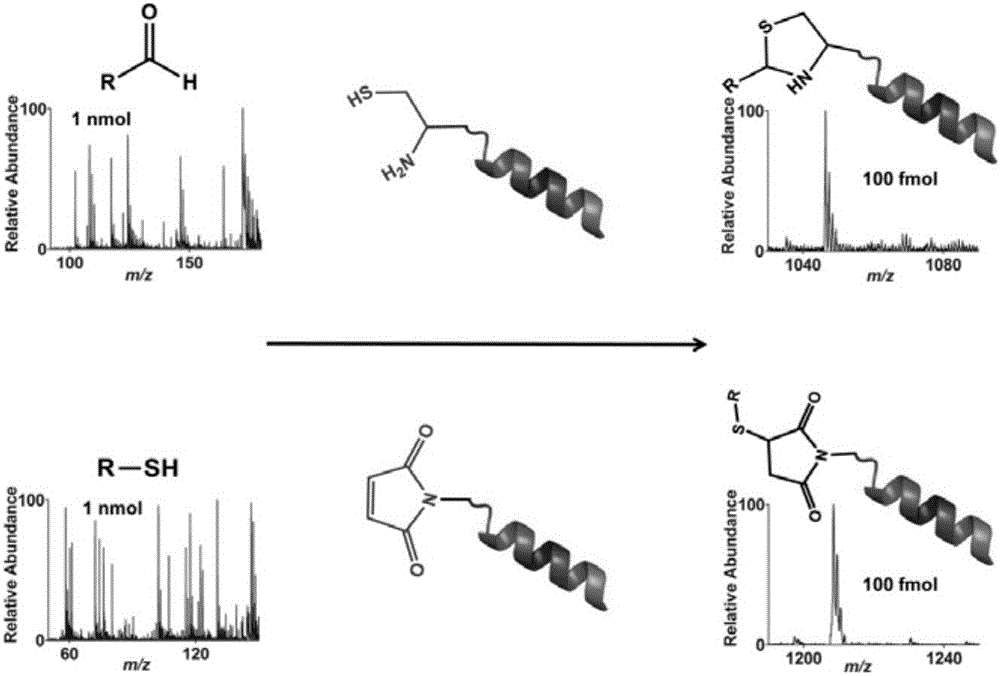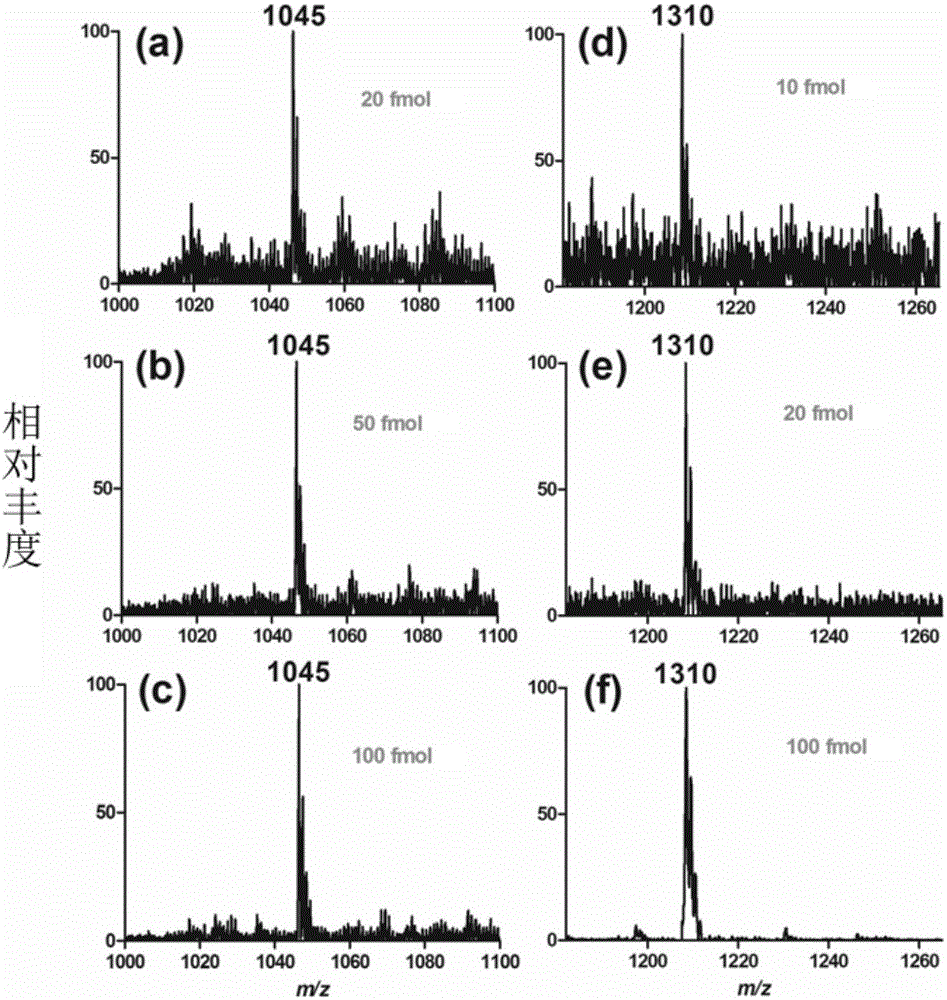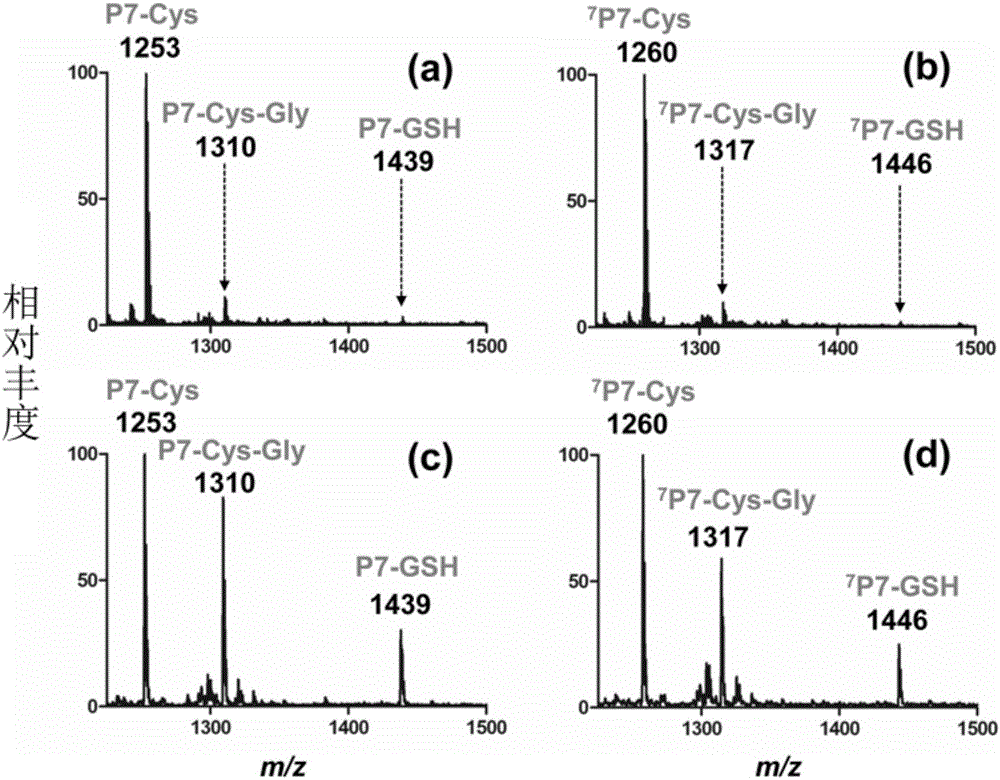Polypeptide deriving method and application thereof to MALDI-TOF-MS detection for small molecule compound
A technology of MALDI-TOF-MS and small molecule compounds, which is applied in the field of mass spectrometry detection, can solve the problems of cumbersome preparation of derivatization reagents, unsuitable detection of small molecular substances of metabolites, matrix interference of target analytes, etc., to facilitate quantitative analysis, High universality and easy operation
- Summary
- Abstract
- Description
- Claims
- Application Information
AI Technical Summary
Problems solved by technology
Method used
Image
Examples
Embodiment 1
[0037] [Example 1] Comparison of MALDI-TOF-MS detection sensitivity before and after derivatization of several aldehyde compounds and sulfhydryl compounds
[0038] Table 1 Comparison of MALDI-TOF-MS detection sensitivity before and after polypeptide derivatization.
[0039]
[0040]
[0041] ND: 1 nmol not detected.
[0042] Analyte unpeptidated derivatization sensitivity: Mix 1 μL test solution with 1 μL matrix (CHCA) to spot the plate; after drying at room temperature, enter matrix-assisted laser desorption ionization-time-of-flight mass spectrometry analysis, and measure its LOD.
[0043] Analyte peptide derivatization sensitivity: after derivatization of small molecule analytes, mix 1 μL of test solution with 1 μL matrix (CHCA) to spot the plate; after drying at room temperature, enter matrix-assisted laser desorption ionization-time-of-flight mass spectrometry to measure its LOD .
Embodiment 2
[0044] [Example 2] Determination of detection limit after derivatization of 3-pyridine formaldehyde and mercaptoethanol
[0045] Different amounts of small molecule analytes (3-pyridinecarbaldehyde, mercaptoethanol) were subjected to peptide derivatization using the above method, mixed with 1 μL of the test solution and 1 μL of matrix (CHCA) to spot the plate; after drying at room temperature, enter the matrix-assisted laser desorption ionization - Time-of-flight mass spectrometry analysis to obtain detection limits for small molecule compounds.
Embodiment 3
[0046] [Example 3] Analysis and detection of sulfhydryl compounds in the urine of lung cancer patients
[0047] Urine samples from lung cancer patients were obtained from Hubei Cancer Hospital through standard clinical channels. The collected urine samples were stored in a -80°C refrigerator. Before sample analysis, the urine sample was centrifuged at 12,000 r / min for 5 min at 4°C, and the supernatant was taken for testing. For the analysis of sulfhydryl compounds, 100 μL of urine samples were reacted with 100 nmol of TCEP at 45 °C for 60 min to reduce disulfide bonds. Then, 20μL urine sample was mixed with 20nmol polypeptide P7 or 7 P7 was added to a phosphate buffer solution with a pH of 6, derivatized at 4°C for 0.5h, 1 μL of the reaction solution was mixed with 1 μL of matrix (CHCA) and spotted on the plate; after air-drying at room temperature, it entered matrix-assisted laser desorption ionization-time-of-flight mass spectrometry, using positive ion reflectance mode a...
PUM
 Login to View More
Login to View More Abstract
Description
Claims
Application Information
 Login to View More
Login to View More - R&D
- Intellectual Property
- Life Sciences
- Materials
- Tech Scout
- Unparalleled Data Quality
- Higher Quality Content
- 60% Fewer Hallucinations
Browse by: Latest US Patents, China's latest patents, Technical Efficacy Thesaurus, Application Domain, Technology Topic, Popular Technical Reports.
© 2025 PatSnap. All rights reserved.Legal|Privacy policy|Modern Slavery Act Transparency Statement|Sitemap|About US| Contact US: help@patsnap.com



